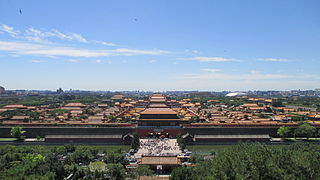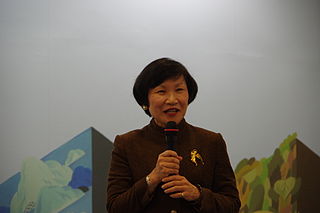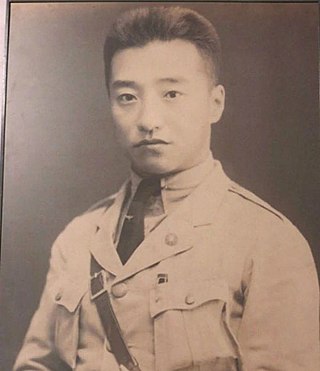
The National Palace Museum is a museum in Taipei,Taiwan. It has a permanent collection of nearly 700,000 pieces of Chinese artifacts and artworks,the majority of which were moved from the Palace Museum in the Forbidden City as well as five other institutions in mainland China during the ROC retreat. These collections had been transferred to several locations before finally being established in 1965 at its present location in Shilin,Taipei. The museum was built between March 1964 and August 1965,with many subsequent expansions making it one of the largest of its type in the world,including a southern branch located in Taibao,Chiayi.

The Forbidden City is the imperial palace complex in the center of the Imperial City in Beijing,China. It was the residence of 24 Ming and Qing dynasty Emperors,and the center of political power in China for over 500 years from 1420 to 1924. The palace is now administered by the Palace Museum. As a UNESCO World Heritage Site,it is one of the most popular tourist attractions in the world. The Forbidden City is arguably the most famous palace in all of Chinese history,and is the largest preserved royal palace complex still standing in the world.

The Palace Museum is a large national museum complex housed in the Forbidden City at the core of Beijing,China. With 720,000 square metres,the museum inherited the imperial royal palaces from the Ming and Qing dynasties of China and opened to the public in 1925 after the last Emperor of China was evicted.

Mukden Palace,or Shenyang Imperial Palace,was the former palace of the Later Jin dynasty and the early Qing dynasty. It was built in 1625,and the first three Qing emperors lived there from 1625 to 1644. Since the collapse of imperial rule in China,the palace has been converted to a museum that now lies in the center of Shenyang,Liaoning.

The Forbidden City was first built in the early-15th century as the palace of the Ming emperors of China. It is located in the centre of Beijing,China,and was the Chinese imperial palace from the early-Ming dynasty in 1420 to the end of the Qing dynasty in 1912,continuing to be home of the last emperor,Puyi,until 1924,since then it has been a museum.
Feng Shaofeng,also known as William Feng,is a Chinese actor. Feng rose to fame with the time travel series Palace (2011). He won the Hundred Flowers Award for Best Actor for his role in the film Wolf Totem (2015). He is also known for his roles in TV series Prince of Lan Ling (2013),The Story of Minglan (2017),Tsui Hark's Detective Dee film series and Cheang Pou-soi's The Monkey King film series.

Chou Kung-shin is a Taiwanese scholar,writer,historian and archaeologist. She served as Director of National Palace Museum from May 2008 till July 2012.

Shih Shou-chien is a Taiwanese scholar,writer,and professor at National Taiwan University. He served as Director of National Palace Museum from May 2004 to January 2006. He is an academician of Academia Sinica.

Lin Jeng-yi was Director of National Palace Museum of the Republic of China from 20 May 2016 to 16 July 2018.

The Southern Branch of the National Palace Museum is a museum in Taibao City,Chiayi County,Taiwan.

The Hong Kong Palace Museum is a public museum in the West Kowloon Cultural District,Hong Kong,exhibiting artifacts from the national Palace Museum at the Forbidden City in Beijing. Construction began in April 2019 and the museum officially opened on 3 July 2022,in commemoration of the 25th anniversary of the handover of Hong Kong.

Shan Jixiang is a Chinese politician,scholar,architect,serves as Dean of Gugong Academy of the Palace Museum. He served as curator of the Palace Museum between 2012 and 2019 and formerly as Director of the National Cultural Heritage Administration.

Wang Xudong is a Chinese researcher and curator of the Palace Museum since 8 April 2019. Previously he served as director of Dunhuang Research Academy. He is an alternate member of the 19th Central Committee of the Chinese Communist Party.

Feng Yong was a Chinese educator,military leader and politician. The eldest son of the warlord Feng Delin,Feng Yong was a member of the Standing Committee of the Northeast Administrative Committee. Feng and Zhang Xueliang were born in the same year and grew up together. Theirs fathers were both strong warlords. Zhang Xueliang would become the “Young Marshal”,while Feng chose to set up a Western-style university in China.
Yang Xin was a Chinese art historian and curator who served as Vice Director of the Palace Museum in Beijing from 1987 to 2000. He edited the 60-volume The Palace Museum‘s Essential Collections as well as its 10-volume English edition,and co-authored Three Thousand Years of Chinese Painting.
Hao Chunrong is a former Chinese politician who spent her entire career in northeast China's Liaoning province. Previously she served as vice governor of Liaoning. She is a delegate to the 13th National People's Congress. In March 2022,she was investigated by China's top anti-corruption agency.
The Secondary Consort of theYehe-Nara clan (侧福晋叶赫那拉氏) was a consort of Hong Taiji. Her personal name was Wuyunzhu (乌云珠).
Chi Kang (1911-2007),also known by the courtesy name Ningfu and the studio name Fushou Kangning Studio,was a Chinese painter and art educator from Cixi,Zhejiang Province,China,known for his skill in painting figures,beauties,flowers and birds,as well as equestrian art.
Jin Shangyi is a contemporary Chinese oil painter within the neoclassical realism movement in Chinese oil painting. From 1987 to 2001,Jin Shangyi served as president of the Central Academy of Fine Arts and professor of the Oil Painting Department.

Xiang Yuanbian (chinese:项元汴,1525–1590),also known by courtesy name Zijing (子京) and art name Molin (墨林),was a native of Jiaxing,Zhejiang Province. He was a prominent Ming dynasty collector and connoisseur of paintings and calligraphies.














